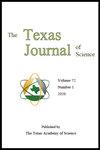NOVEL TEMPORARY AQUATIC HABITATS AND DESERT INVERTEBRATE COMMUNITIES
Q4 Agricultural and Biological Sciences
引用次数: 0
Abstract
The addition of desert water developments alleviates water stress for a variety of organisms and is likely necessary for some species as water availability from other isolated water sources declines with climate change. However, constructed water catchments are different structurally and do not cycle water the same way as natural sites. We assessed whether these novel habitats, the constructed catchments of the Sonoran Desert, function as ecological equivalents of the natural waters and evaluated their effects on macroinvertebrate biodiversity, community composition, and trophic function. We documented an accumulation of ammonia and less diversity and different taxa assemblages in the novel habitat. We also documented a more heterotrophic food web in the natural water basins that are more dependent on resource pulses, and a more autotrophic food web in novel habitats that are more dependent on primary production from the open catchment basin. As natural resource managers continue to add constructed waters to mitigate for climate change induced declines in water availability, organisms are more likely to encounter these novel habitats as they disperse. Consequently, by increasing the density of these novel habitats we are having a measurable effect on the types of species and trophic groups present as well as the ecosystem cycling of energy and nutrients across the desert landscape. The consequences of these shifts in invertebrate community composition and ecosystem cycling on the larger desert ecosystem is unknown.新的临时水生栖息地和沙漠无脊椎动物群落
沙漠水开发的增加缓解了各种生物的水压力,对一些物种来说可能是必要的,因为其他孤立水源的水供应量随着气候变化而下降。然而,建造的集水区结构不同,不会像自然场地那样循环用水。我们评估了这些新的栖息地,即索诺兰沙漠的人工集水区,是否具有天然水域的生态等效性,并评估了它们对大型无脊椎动物生物多样性、群落组成和营养功能的影响。我们记录了新栖息地中氨的积累和较少的多样性以及不同的分类群组合。我们还记录了在更依赖资源脉冲的自然流域中存在更为异养的食物网,在更依赖开放集水区初级生产的新栖息地中存在更自养的食物网络。随着自然资源管理者继续增加人工水域,以缓解气候变化导致的水资源可用性下降,生物在分散时更有可能遇到这些新的栖息地。因此,通过增加这些新栖息地的密度,我们对存在的物种和营养群的类型以及沙漠景观中能量和营养的生态系统循环产生了可衡量的影响。无脊椎动物群落组成和生态系统循环的这些变化对更大的沙漠生态系统的影响尚不清楚。
本文章由计算机程序翻译,如有差异,请以英文原文为准。
求助全文
约1分钟内获得全文
求助全文
来源期刊

The Texas Journal of Science
Agricultural and Biological Sciences-Ecology, Evolution, Behavior and Systematics
CiteScore
0.50
自引率
0.00%
发文量
2
期刊介绍:
Scholarly manuscripts reporting original research results in any field of science or technology, including science education, will be considered for publication in The Texas Journal of Science. Prior to acceptance, each manuscript will be reviewed by both knowledgeable peers and the editorial staff. Authors are encouraged to suggest the names and addresses of two potential reviewers to the Manuscript Editor at the time of submission of their manuscript.
 求助内容:
求助内容: 应助结果提醒方式:
应助结果提醒方式:


